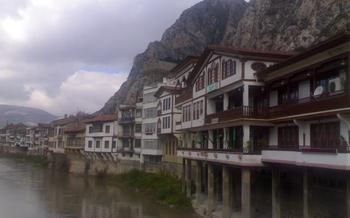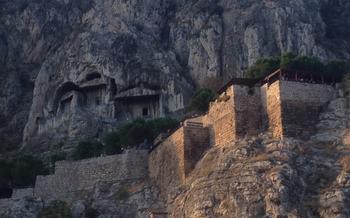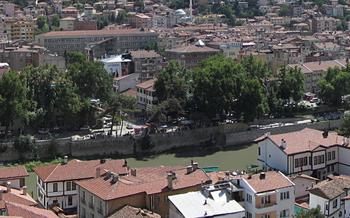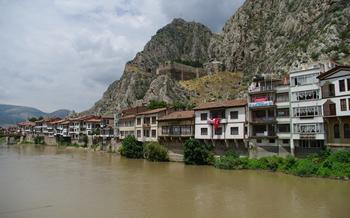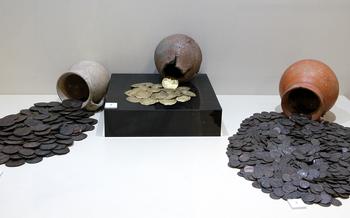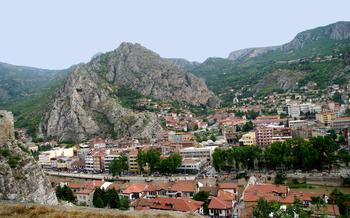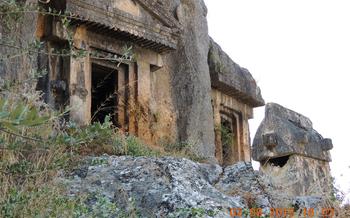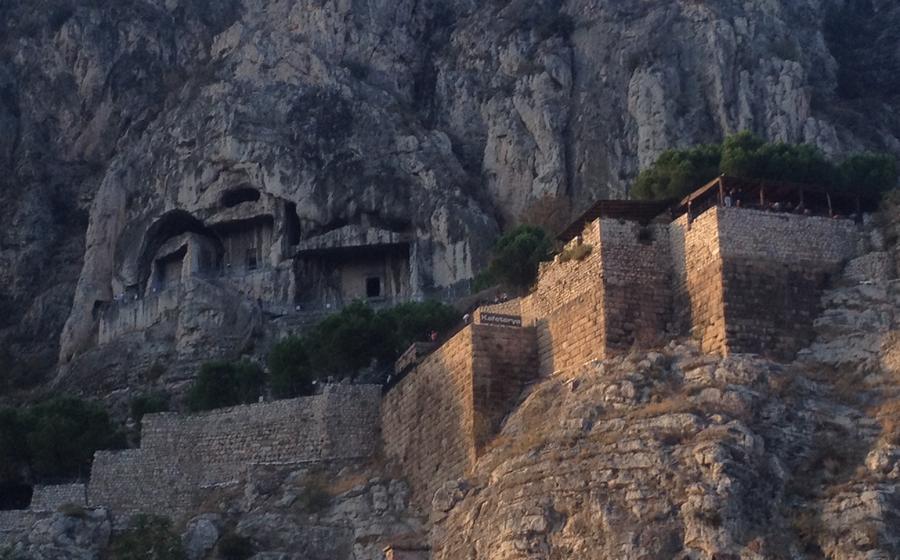
Kral Kaya Tombs
- Historical Significance
- Location and Accessibility
- Architectural Features
- Interior Discoveries
- Visiting Hours and Fees
- Guided Tours
- Self-Guided Exploration
- Photography Opportunities
- Cultural Significance
- Historical Context
- Nearby Attractions
- Best Time to Visit
- Food and Accommodations
- Practical Tips
- Insider Tip: A Hidden Gem Unveiled
Historical Significance
The Kral Kaya Tombs, located in the heart of Amasya, Turkey, stand as a testament to the ancient Kingdom of Pontus. These magnificent rock-cut tombs were carved into the sheer cliffs overlooking the city, serving as the final resting place for the kingdom's rulers and their families.
During the Hellenistic period, the Kingdom of Pontus emerged as a powerful force in the region, stretching from the Black Sea coast to the foothills of the Taurus Mountains. Under the rule of kings such as Mithridates VI Eupator, Pontus became a formidable rival to the Roman Republic, engaging in a series of wars that ultimately led to its downfall.
The Kral Kaya Tombs, with their elaborate facades and intricate carvings, reflect the opulence and power of the Pontic kingdom. They were not merely burial chambers but symbols of status and authority, showcasing the wealth and prestige of the royal family. Moreover, the tombs held deep religious significance, as they were believed to be the gateway to the afterlife, where the deceased rulers would join their divine ancestors.
Location and Accessibility
The Kral Kaya Tombs are located in the city of Amasya, which is situated in the northern region of Turkey. The tombs are carved into the steep cliffs overlooking the Yeşil River, offering breathtaking views of the surrounding landscape. To reach the tombs, visitors can follow the scenic Yeşilırmak Valley Road and turn onto the Kral Kaya Road. The tombs are well-signposted and easily accessible by car. Public transportation options are also available, with buses departing from the city center to the tombs. The tombs are open to visitors daily, with extended hours during the summer months. Parking is available near the site, making it convenient for visitors to explore the tombs at their leisure. While the tombs are generally accessible, visitors with disabilities may need assistance navigating the uneven terrain and narrow passages within the tombs.
Architectural Features
The Kral Kaya Tombs are renowned for their exceptional architectural features that showcase the skill and artistry of the ancient Pontus artisans. Carved directly into the sheer rock face, the tombs display intricate facades adorned with beautiful carvings, inscriptions, and decorative elements. The most striking feature of these tombs is their unique rock-cut architecture. Each tomb consists of a large chamber with a rectangular entrance, often decorated with elaborate moldings and friezes.
The interiors of the tombs are equally impressive, featuring vaulted ceilings, niches, and benches carved into the rock. The walls are adorned with intricate carvings and bas-reliefs depicting various scenes, including hunting, banquets, and religious ceremonies. These carvings offer valuable insights into the lives, customs, and beliefs of the ancient Pontus people. The tombs also feature impressive architectural elements such as columns, pilasters, and pediments, demonstrating the influence of Greek and Roman architectural styles.
The construction techniques employed in the creation of these tombs are remarkable, considering the limited tools and technology available at the time. The tombs were carefully carved out of the rock using chisels and hammers, and the precision of the cuts is astonishing. The builders also used a variety of techniques to ensure the stability and longevity of the tombs, such as corbelled arches and interlocking blocks. As a result, the Kral Kaya Tombs have withstood the test of time and remain remarkably well-preserved, showcasing the enduring legacy of the ancient Pontus kingdom.
Interior Discoveries
The Kral Kaya Tombs have yielded a treasure trove of archaeological discoveries that shed light on the lives and customs of the ancient Pontus people. Excavations have unearthed a variety of artifacts, including pottery, jewelry, coins, and weapons, providing valuable insights into their material culture. Inscriptions and carvings found within the tombs have also helped to decipher the language and writing system of the Pontus Kingdom.
One of the most significant discoveries was a well-preserved royal burial chamber, complete with the remains of a high-ranking individual adorned with elaborate jewelry and accompanied by valuable grave goods. This discovery provided tantalizing clues about the burial practices and social customs of the ancient Pontus rulers.
Ongoing research and excavations at the tombs continue to yield new insights into the history and culture of this ancient kingdom. Recent excavations have uncovered additional chambers and artifacts, shedding further light on the daily lives, religious beliefs, and artistic traditions of the Pontus people. Visitors to the tombs can learn about these exciting discoveries and the ongoing research that is helping to piece together the rich tapestry of the Pontus Kingdom's history.
Visiting Hours and Fees
The Kral Kaya Tombs are open to visitors daily, allowing for flexibility in scheduling a visit. However, it is important to note that the operating hours may vary depending on the season and public holidays. To avoid disappointment, it is advisable to check the official website or contact the local tourism office for the most up-to-date information.
There is a modest entrance fee required to visit the tombs, which helps support the preservation and maintenance of this historical site. The fee is typically affordable and can be paid on-site at the ticket counter. It is recommended to carry cash for convenience, as card payments may not always be accepted.
Guided tours are also available for an additional fee, offering visitors the opportunity to delve deeper into the history and significance of the tombs. These tours are led by knowledgeable guides who provide insightful commentary and answer any questions that visitors may have. Booking a guided tour in advance is recommended, especially during peak tourist season, to secure a spot and avoid long waiting times.
Guided Tours
Guided tours of the Kral Kaya Tombs are highly recommended for visitors who want to gain a deeper understanding of their historical significance and cultural context. These tours, often led by experienced historians or archaeologists, provide a wealth of information that enhances the visitor experience.
Guides can point out hidden details and explain the symbolism and significance of the tombs' architectural features, inscriptions, and artifacts. They can also share insights into the lives and customs of the ancient Pontus people, bringing the history of the tombs to life.
Guided tours typically last for an hour or two and cover the main highlights of the site. Visitors can choose from a variety of tour options, including private tours for a more personalized experience or group tours for a more social and interactive experience.
It is advisable to book guided tours in advance, especially during peak tourist season, to secure a spot and avoid long waiting times. Visitors can book tours through local tour operators, online platforms, or directly at the tomb site.
Self-Guided Exploration
For independent travelers who prefer to explore at their own pace, the Kral Kaya Tombs offer a rewarding experience. Embark on a self-guided tour, allowing yourself to immerse in the ancient history and marvel at the intricate details of the tombs. To enhance your exploration, consider bringing a guidebook or downloading a mobile app that provides detailed information about each tomb. You can also rent an audio guide at the entrance to listen to historical narratives and insights as you wander through the site. Remember to respect the tombs and their surroundings, following any regulations or guidelines in place for self-guided exploration.
Photography Opportunities
The Kral Kaya Tombs offer a treasure trove of photographic opportunities for visitors with a keen eye for capturing the beauty and historical significance of this ancient site. The towering rock-cut facades, intricate carvings, and unique angles create a visually stunning backdrop for photography enthusiasts. Wide-angle lenses can capture the grandeur of the tombs against the backdrop of the surrounding landscape, while close-ups can reveal the delicate details and craftsmanship of the carvings. The play of light and shadow throughout the day adds another dimension to the photographic possibilities, allowing visitors to capture the tombs in different moods and atmospheres.
It is advisable for photographers to come prepared with the appropriate equipment to make the most of their visit. A wide-angle lens is essential for capturing the scale and majesty of the tombs, while a tripod can help stabilize the camera for sharp shots, especially in low-light conditions. Visitors should also be mindful of any photography restrictions or guidelines that may be in place to protect the tombs and the privacy of other visitors.
Cultural Significance
The Kral Kaya Tombs hold significant cultural value as emblems of Amasya's rich history and cultural heritage. These ancient burial chambers have become a source of pride for the local community and a popular destination for both domestic and international tourists. The tombs have captured the imagination of visitors with their intriguing history, exquisite carvings, and unique architectural style.
Over the centuries, the Kral Kaya Tombs have been featured in local legends, stories, and traditions, adding to their cultural significance. One popular legend tells the tale of a young prince who was buried in one of the tombs alongside his beloved horse. Visitors are often drawn to the tombs to witness the poignant carvings depicting the prince and his horse, which have become symbols of love and loyalty.
The tombs have also become a symbol of Amasya's cultural diversity and its role as a crossroads of civilizations. The architectural style of the tombs reflects influences from various cultures, including Persian, Greek, and Roman, showcasing the region's rich cultural heritage. As visitors explore the tombs, they can trace the footsteps of ancient civilizations and gain a deeper appreciation for the cultural tapestry of Amasya.
Historical Context
The region surrounding Amasya has a rich and diverse historical tapestry, with various civilizations and empires leaving their mark on the area. In ancient times, the region was part of the powerful Kingdom of Pontus, ruled by the Mithridatic dynasty. The kingdom's strategic location at the crossroads of trade routes made it a center of cultural exchange and a hub of commerce.
The Kral Kaya Tombs are a testament to the grandeur and opulence of the Kingdom of Pontus. Built in the 4th century BC, the tombs served as burial chambers for the kingdom's rulers and their families. The tombs' intricate carvings and impressive architectural features reflect the kingdom's wealth and power.
After the fall of the Kingdom of Pontus, the region came under the rule of various empires, including the Roman, Byzantine, and Ottoman Empires. Each empire left its mark on the region, contributing to its rich cultural heritage. The Kral Kaya Tombs, with their enduring presence, stand as a testament to the region's resilience and the diverse civilizations that have shaped its history.
Nearby Attractions
After immersing yourself in the history of the Kral Kaya Tombs, take the opportunity to explore other captivating attractions that Amasya has to offer. For those with a penchant for history, the city boasts several notable landmarks, including the Amasya Castle, which offers panoramic views of the region from its hilltop perch, and the ancient ruins of the Harşena Fortress, a testament to the city's rich past.
Nature enthusiasts will delight in exploring the many natural wonders surrounding Amasya. The Yeşilırmak River, which meanders through the city, offers scenic boat tours that showcase the region's natural beauty. The city's parks, such as the Merkez Park and the Amasya Kent Park, provide tranquil havens for relaxation and recreation, with lush greenery, walking paths, and playgrounds for children.
To delve deeper into the local culture, visit the Amasya Museum, which houses a fascinating collection of artifacts that tell the story of the city's rich history and cultural heritage. The museum's exhibits range from archaeological finds to traditional handicrafts, offering visitors a glimpse into the lives and traditions of the people of Amasya.
For those seeking unique shopping experiences, the city's vibrant bazaars and markets are a must-visit. The Amasya Bazaar, located in the heart of the city, offers a kaleidoscope of colors and aromas, with vendors selling everything from traditional Turkish handicrafts to fresh produce and local delicacies.
Whether you're interested in history, nature, culture, or shopping, Amasya has something to offer every traveler. Take the time to explore beyond the Kral Kaya Tombs and discover the many hidden gems that this charming city has to offer.
Best Time to Visit
Timing is crucial when planning a trip to the Kral Kaya Tombs to ensure an optimal experience. While Amasya welcomes visitors year-round, each season offers unique advantages and considerations.
Spring (April-May) is an ideal time to visit. The weather is pleasant and mild, with temperatures ranging from 15 to 25 degrees Celsius. The crowds are generally smaller during this period, allowing for a more serene exploration of the tombs. Additionally, the surrounding landscapes are adorned with vibrant wildflowers, creating a picturesque backdrop for your visit.
Summer (June-August) offers longer daylight hours, allowing for extended exploration of the tombs and the surrounding area. However, temperatures can soar during this time, reaching up to 35 degrees Celsius. It's advisable to start your visit early in the morning or late in the afternoon to avoid the midday heat. Don't forget to carry water and sunscreen to stay hydrated and protected.
Autumn (September-October) is a delightful season to visit the Kral Kaya Tombs. The weather remains warm and comfortable, with temperatures hovering between 15 and 25 degrees Celsius. The crowds are smaller compared to the summer months, making it an ideal time for those seeking a peaceful and tranquil experience.
Winter (November-March) brings a different charm to the Kral Kaya Tombs. While the weather can be cold and unpredictable, with temperatures dropping below 10 degrees Celsius, the tombs take on a unique and atmospheric appeal. The absence of crowds during this time allows for a more intimate and reflective exploration of these ancient burial chambers.
Food and Accommodations
Amasya offers a diverse range of dining options and accommodations to cater to different tastes and budgets. Visitors can savor traditional Turkish cuisine at local restaurants, indulge in delicious pastries at historic cafes, or enjoy a scenic meal overlooking the Yesilirmak River. For a truly authentic experience, try the "Amasya Çörek," a sweet pastry filled with walnuts and pistachios, or the "Amasya Kebabı," a tender lamb dish cooked in a clay pot.
Accommodation options in Amasya range from budget-friendly guesthouses to luxurious hotels. Many hotels offer stunning views of the city and the surrounding mountains, making them the perfect place to unwind after a day of exploring the Kral Kaya Tombs and other attractions. For a unique experience, consider staying in a traditional Turkish house or a cave hotel, which offer a glimpse into the region's rich history and culture.
Practical Tips
- Visitors should come prepared for the terrain by wearing comfortable and sturdy shoes suitable for walking on uneven surfaces, as the path leading to the tombs can be rugged.
- It is advisable to bring a water bottle and sunscreen, especially during the hot summer months, as there is limited shade in the area surrounding the tombs.
- For those who wish to explore the interior of the tombs, it is recommended to bring a flashlight or headlamp, as the lighting inside can be limited.
- Visitors should be mindful of the fragile nature of the tombs and avoid touching or leaning against the carvings and inscriptions to prevent damage.
- It is important to respect the cultural and religious significance of the site by behaving respectfully and refraining from any inappropriate behavior or language.
Insider Tip: A Hidden Gem Unveiled
Beyond the well-trodden paths of the Kral Kaya Tombs lies a hidden gem that offers a unique perspective on this ancient site. A short walk from the tombs, nestled amidst tranquil gardens, is a secluded viewpoint that unveils a breathtaking panorama of the surrounding landscape. From this vantage point, visitors can marvel at the tombs' majestic presence as they seamlessly blend into the rugged cliffs, creating a picture-perfect postcard moment. The seclusion of this spot allows for a serene and contemplative experience, inviting visitors to immerse themselves in the history and beauty of the Kral Kaya Tombs without the distractions of crowds. Whether you're a seasoned traveler or a first-time visitor, this hidden gem promises a memorable and awe-inspiring moment during your exploration of Amasya's rich cultural heritage.

